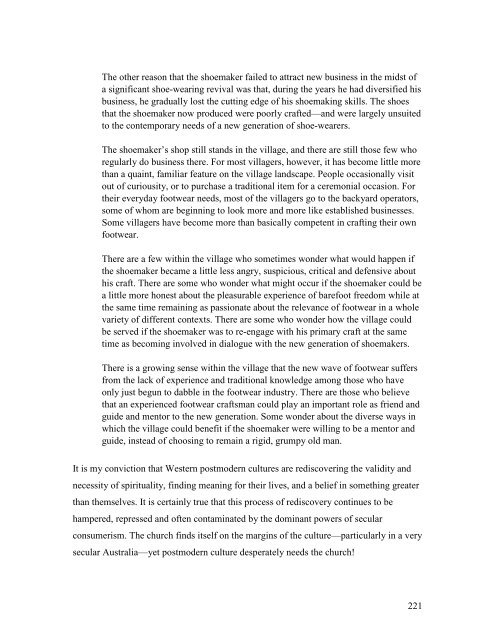Introductory notes for readers of this thesis - Theses - Flinders ...
Introductory notes for readers of this thesis - Theses - Flinders ...
Introductory notes for readers of this thesis - Theses - Flinders ...
You also want an ePaper? Increase the reach of your titles
YUMPU automatically turns print PDFs into web optimized ePapers that Google loves.
The other reason that the shoemaker failed to attract new business in the midst <strong>of</strong>a significant shoe-wearing revival was that, during the years he had diversified hisbusiness, he gradually lost the cutting edge <strong>of</strong> his shoemaking skills. The shoesthat the shoemaker now produced were poorly crafted—and were largely unsuitedto the contemporary needs <strong>of</strong> a new generation <strong>of</strong> shoe-wearers.The shoemaker’s shop still stands in the village, and there are still those few whoregularly do business there. For most villagers, however, it has become little morethan a quaint, familiar feature on the village landscape. People occasionally visitout <strong>of</strong> curiousity, or to purchase a traditional item <strong>for</strong> a ceremonial occasion. Fortheir everyday footwear needs, most <strong>of</strong> the villagers go to the backyard operators,some <strong>of</strong> whom are beginning to look more and more like established businesses.Some villagers have become more than basically competent in crafting their ownfootwear.There are a few within the village who sometimes wonder what would happen ifthe shoemaker became a little less angry, suspicious, critical and defensive abou<strong>this</strong> craft. There are some who wonder what might occur if the shoemaker could bea little more honest about the pleasurable experience <strong>of</strong> barefoot freedom while atthe same time remaining as passionate about the relevance <strong>of</strong> footwear in a wholevariety <strong>of</strong> different contexts. There are some who wonder how the village couldbe served if the shoemaker was to re-engage with his primary craft at the sametime as becoming involved in dialogue with the new generation <strong>of</strong> shoemakers.There is a growing sense within the village that the new wave <strong>of</strong> footwear suffersfrom the lack <strong>of</strong> experience and traditional knowledge among those who haveonly just begun to dabble in the footwear industry. There are those who believethat an experienced footwear craftsman could play an important role as friend andguide and mentor to the new generation. Some wonder about the diverse ways inwhich the village could benefit if the shoemaker were willing to be a mentor andguide, instead <strong>of</strong> choosing to remain a rigid, grumpy old man.It is my conviction that Western postmodern cultures are rediscovering the validity andnecessity <strong>of</strong> spirituality, finding meaning <strong>for</strong> their lives, and a belief in something greaterthan themselves. It is certainly true that <strong>this</strong> process <strong>of</strong> rediscovery continues to behampered, repressed and <strong>of</strong>ten contaminated by the dominant powers <strong>of</strong> secularconsumerism. The church finds itself on the margins <strong>of</strong> the culture—particularly in a verysecular Australia—yet postmodern culture desperately needs the church!221















